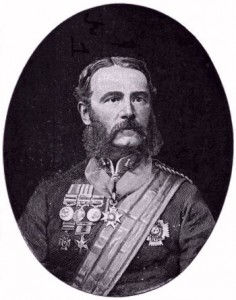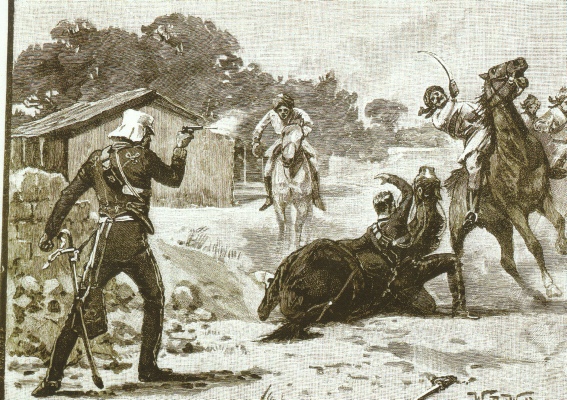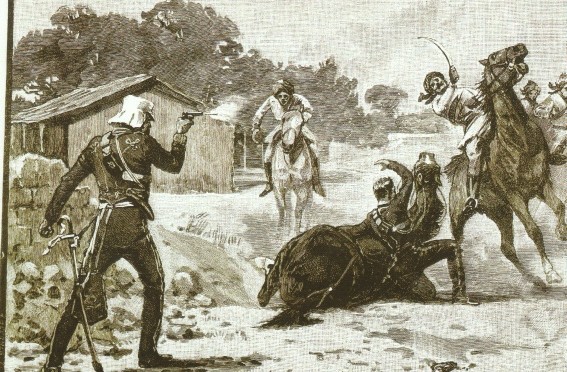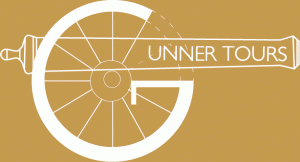 9th July is the anniversary of the action for which Captain Henry Tombs https://en.wikipedia.org/wiki/Henry_Tombs of the Bengal Horse Artillery was awarded the Victoria Cross, and became the honour title of “Tombs’ Troop” , now 28/143 battery (Tombs Troop)
9th July is the anniversary of the action for which Captain Henry Tombs https://en.wikipedia.org/wiki/Henry_Tombs of the Bengal Horse Artillery was awarded the Victoria Cross, and became the honour title of “Tombs’ Troop” , now 28/143 battery (Tombs Troop)
Tombs was awarded the VC for coming to the assistance of one of his subalterns who had got into a spot of bother in hand to hand combat with mutineers. The citation says: “For very gallant conduct on the part of Lieutenant Hills before Delhi, in defending the position assigned to him in case of alarm, and for noble behaviour on the part of Lieutenant-Colonel Tombs in twice coming to his subaltern’s rescue, and on each occasion killing his man.”
The citation references a dispatch by Lieutenant-Colonel M. Mackenzie’s which reads:
Despatch No. 40, Lieut.-Colonel M. Mackenzie, commanding 1st Brigade Horse Artillery, to Brigadier A. Wilson, Commandant
of Artillery.
CAMP NEAR DELHI,
July 10, 1857.
SIR,—“It is with great pleasure I submit, for the information of the Brigadier Commandant, the following account of the very gallant conduct of Second Lieut. James Hills, of the 2nd Troop, 1st Brigade Horse Artillery, and the noble behaviour of his commanding officer, Major H. Tombs, in twice coming to his subaltern’s rescue and on each occasion killing his man.
Yesterday, the 9th inst., Second-Lieut. J. Hills was on picket-duty, with two guns, at the mound to the right of the camp. About eleven o’clock a.m. there was a rumour that the enemy’s cavalry were coming down on this post. Lieut. Hills proceeded to take up the position assigned in case of alarm, but before he reached the spot he saw the enemy close upon his guns, before he had time to form up. To enable him to do this, Lieut. Hills boldly charged, single handed, the head of the enemy’s column, cut down the first man, struck the second and was then ridden down, horse and all.
On getting up and searching for his sword, three more men
came at him (two mounted). The first man he wounded with his pistol, he caught the lance of the second with his left hand, and
wounded him with his sword. The first man then came on again and was cut down; the third man (on foot) then came up and
wrenched the sword from the hand of Lieut. Hills (who fell in the struggle), and the enemy was about to cut him down when Major Tombs (who had gone up to visit his two guns) saw what was going on, rushed in and shot the man and saved Lieut. Hills. By this time the enemy’s cavalry had passed by, and Major Tombs and Lieut. Hills went to look after the wounded men, when Lieut. Hills observed one of the enemy passing with his (Lieut. Hills’) pistol. They walked towards him. The man began flourishing his sword and dancing about. He first cut at Lieut. Hills, who parried the blow, and he then turned on Major Tombs, who received the blow in the same manner. His second attack on Lieut. Hills was, I regret to say, more successful, as he was cut down with a bad sword-cut on the head, and would have been no doubt killed had not Major Tombs rushed in and put his sword through the man. I feel convinced that such gallant conduct on the part of these two officers has only to be brought properly forward to meet with an appropriate reward. Major Tombs was saved from a severe sword cut on the head by the wadded head-dress he wore.
“(Signed) M. MACKENZIE,
“Lieut.-Colonel.”The Tombs claimed that his folded military cloak saved his life from the sword thrusts of his opponents.
 There was a lot more to Henry Tombs than this act of gallantry. Here is what Field Marshal Lord Roberts of Kandahar had to say about him in his autobiography “Forty One Years years in India”
There was a lot more to Henry Tombs than this act of gallantry. Here is what Field Marshal Lord Roberts of Kandahar had to say about him in his autobiography “Forty One Years years in India”
I longed to meet and know the men who names were in everyone’s mouth. The hero of the day was Henry Tombs, of the Bengal Horse Artillery, an unusually handsome man and a thorough soldier. His gallantry in the attack on the Idgah (a Mahomedan place of worship and sacrifice) and wherever he had been engaged was the general talk of the camp. I had always heard of Tombs as one of the best officers in the regiment, and it was with feelings of respectful admiration that I made his acquaintance a few days later.
Jemmy Hills, one of the subalterns in Tomb’s troop, was an old Addiscombe friend of mine; he delighted in talking of his Commander, in dilating on his merits as a soldier and his skill in handling each arm of the service. As a cool, bold leader of men, Tombs was unsurpassed ; no fire, however hot, and no crisis, however unexpected, could take him by surprise ; he grasped the situation in a moment and issued his orders without hesitation, inspiring all ranks with confidence in his power and capacity. He was somewhat of a martinet, and was more feared than liked by his men until they realized what a grand leader he was, when they gave him their entire confidence and were ready to follow him anywhere and everywhere.” Page 175.
And:
On the 17th (September, 1857) we were attacked from almost every direction— a manoeuvre intended to prevent our observing a battery which was being constructed close to an Idgah situated on a hill to our right, from which to enfilade our position on the Ridge. As it was very important to prevent the completion of this battery, Barnard ordered it to be attacked by two small columns, one commanded by Tombs, of the Bengal Horse Artillery, the other by Reid. Tombs, with 400 of the 6oth Rifles and 1st Bengal Fusiliers, thirty of the Guides Cavalry, twenty Sappers and Miners and his own troop of Horse Artillery, moved towards the enemy’s left. . . . Tombs drove the rebels through a succession of gardens, till they reached the Idgah, where they made an obstinate but unavailing resistance. The gates of the mosque were blown open and thirty-nine of its defenders were killed. Tombs himself was slightly wounded and had two horses killed, making five which had been shot under this gallant soldier since the commencement of the campaign.” Page 169.
Henry Tombs was a veteran of dozens of campaigns over twenty years of service and his military career is the story of the British Army in India. As a twenty year old Subaltern he was ADC to Sir Harry Smith, who had stormed Badajoz in the Peninislar war under Wellington. Tombs was promoted to major general at the age of 42, but died aged 49 of sickness.
However, James Hill, http://www.britishmedals.us/people/hills.html the subaltern Tombs saved, and awarded the VC for the same action lived to the age of 85 and died in 1919 as a Lieutenant General , living through the first world war. He maintained his friendship with Lord Roberts choosing to spend some of his retirement on campaign in South Africa during the Boer War serving in a private capacity on Lord Robert’s staff. (Is this an extreme form of battlefield tourism?)
The battery that he had served in fighting with sword and revolver had become 56th Howitzer battery RFA which served on the Western Front throughout the First World War and took part in the battle for Delville Wood on the Somme 100 years ago this month in late July 1916.
To visit the battlefields of the Royal Artillery for battlefield tours, staff rides and battlefield studies contact Gunner Tours info@gunnertours.com


